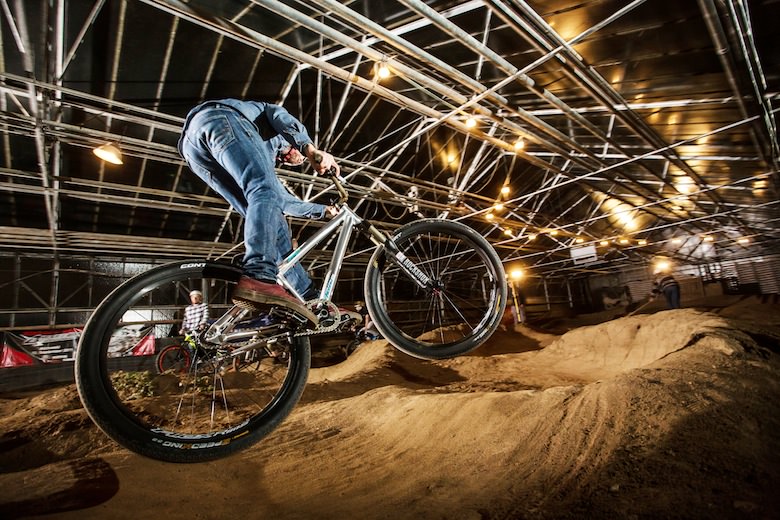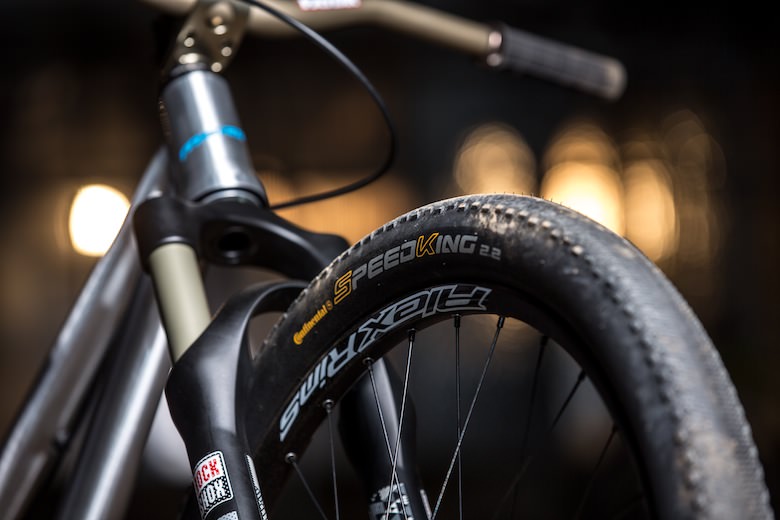What’s better than mixing business with pleasure? The sudden and dramatic spread of pump tracks offers exceptional workout conditions for every ambitious enduro rider. Pump tracks not only push the fun meter all the way to the top, but also help to improve riding techniques and fitness. All of these are important aspects to make use of during an ordinary ride, as well as during a focused workout. Everything that works well on the pump track can be applied off-road.

You begin with the build-up of speed – which the name ‘pump track’ itself already connotes – you have to pump the terrain in order to gain speed. In addition, manualling and jumping improve important and useful skills that can be transferred well to deeptread everyday life.

To “read” the terrain and deliberately push to increase speed pays off, since this way is usually faster than dull pedaling on hazards. On top of that, it saves you a lot of energy and provides a certain flow to your sequence of movements. The improvement of your ability to react, due to the fast series of rollers and berms on a pump track, features another advantage that we can transfer to trail riding. This is where the entire locomotor system is being trained, especially regarding coordination. Legs and arms, as well as upper body and mind, need to be in perfect synchronicity. Sufficient practice and exercise eventually turn everything from being hard work, to automaticity and ease. You loosen up from workout to workout and are able to increase your speed.


“PUMP TRACKS ARE EXTREMELY USEFUL, ESPECIALLY IN REGARDS TO THE PRECISION AND COORDINATION OF UPPER AND LOWER BODY. IT IS ALSO GOOD CARDIO-TRAINING BECAUSE YOU’RE TOTALLY OUT OF BREATH AFTER ONLY A FEW LAPS.” – Jerome Clementz, Team Cannondale
Change of direction: a pump track is not a never-ending straight line but a cohesive system with corresponding berms. The right feeling for berms is crucial. Most people forget or simply do not manage to take advantage of the berms in order to use them as a chance to benefit from momentum or even to accelerate.

“GENERALLY SPEAKING, IT HELPS YOU WITH ANY KIND OF DISCIPLINE IN MOUNTAIN BIKING, AS IT IS ALWAYS ABOUT THE MOMENTUM, SECTIONS TO RIDE STANDING UP, AND TURNS THAT HAVE EXTREME IMPACT ON YOUR GROUND SPEED. YOUR FLOW IS OF EXTREME IMPORTANCE! YOU USUALLY KNOW THE ENDURO STAGES ONLY PARTIALLY, OR NOT AT ALL, WHICH MAKES IT EVEN MORE IMPORTANT TO RIDE SMOOTHLY AND WITH THE GOOD TEMPO THAT COMES THROUGH FLOW.” – Andre Wagenknecht, Cube Action Team
No matter whether it’s a single fast round or 15 continuous laps, everything varies according to the intention of the individual. This is where the perfect combination of fun and work- out becomes full circle and we forget about the sweaty smell of monotonous gyms. It isn’t surprising at all, as a refurbished greenhouse offers a pump track, and therefore first class opportunities to enjoy long winter nights.

“MOST OF ALL, WE RIDE PUMP TRACKS FOR FUN. THE FACT THAT IT IS A PERFECT WORKOUT AT THE SAME TIME IS A PLEASANT SIDE-EFFECT… THE MOUNDS AND ROLLERS ON ENDURO TRACKS ARE DEFINABLY HANDLED FASTER BY PUMPING AND SURFING. THIS IS EXACTLY WHAT YOU PRACTICE WELL ON PUMP TRACKS.” – Carolin & Anita Gehrig, Twins MTB Racing
What kind of Bike do I need to ride Pumptracks?
There is not really a specific answer to this question, as pump tracks can basically be ridden with almost any two-wheeled contraption including BMX, MTB, 20”, 26”, 29”, aluminum, carbon, and steel. Generally, however, we may say that the majority of ambitious pump track riders go for compact 26” hardtails with suspension forks.

We built up such a workout bike, of course including a gentle touch of love for detail. A light and stiff Merida aluminum frame (Hardy Team) serves as the basis.
The Hardy Team frame, by Merida (in our case a prototype), not only looks especially neat, but also lives up to its promises: its 1.6 kg offers the perfect basis for a light hardtail. 9.4 kg, including pedals without any risky experiments, speaks for itself. The frame will weigh 1.9 kg for series production (designed for hard dirt tracks).
Yet again, this is where we apply a general rule: as much as necessary, as little as possible. An easily modulated rear brake is totally sufficient for pumping, just as you only need a single speed. Our main focus is on light, stiff, and at the same time solid wheels. Our solution: the specifically designed Acros 1G single-speed hubs go without a disk brake system, providing a greater flange distance and more stability, despite the radial lacing design, combined with DT spokes, aluminum nipples, light rims, 59 Gramm Eclipse tubes, and fast rolling Continental Speed King tires. This guarantees acceleration, stability, and low rotating mass.

The front is equipped with a matte black firm tuned RockShox Argyle RC fork. The cockpit is completed by an Acros headset in combination with a stem by Renthal, the cult brand based in England. What else could you ask for?
Weight: 9.4 kg without having to make any sacrifices. Is light weight mandatory? Not necessarily. As soon as the weight fetishism is at the expense of stability and riding quality, this is where the weight negotiation stops – even on pump tracks.

What kind of Equipment do I need to Ride Pumptracks?
Biking could hardly be any less complicated than on pump tracks: A helmet and bike are the only necessary tools. Other than that, maintenance of the track, as well as due respect to locals, goes without saying. As soon as you have internalized these basics, you are ready to start pumping and pulling – except maybe for when it’s bad weather. But that’s why we have a roof over our heads for now…
Read more stories in our ENDURO issues – free & digital, of course!
Words: Daniel Häberle | Photos: Oliver Roggenbuck
Did you enjoy this article? If so, we would be stoked if you decide to support us with a monthly contribution. By becoming a supporter of ENDURO, you will help secure a sustainable future for high-quality mountain bike journalism. Click here to learn more.








